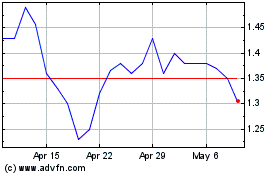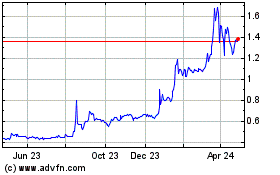Freddie Mac's New Multi-Indicator Market Index Measures Stability of Metro, State and National Housing Markets
March 26 2014 - 10:00AM
Marketwired
Freddie Mac's New Multi-Indicator Market Index Measures Stability
of Metro, State and National Housing Markets
Draws From Multiple Data Sources to Measure Housing Market
Stability and Trends; Key Findings Show Many States, Metros Still
Outside Stable Range
MCLEAN, VA--(Marketwired - Mar 26, 2014) - Freddie Mac
(OTCQB: FMCC) today released its inaugural Freddie Mac
Multi-Indicator Market Index(SM) (MiMi(SM)). MiMi is a new
publicly-accessible tool that monitors and measures the stability
of the nation's housing market, as well as the housing markets of
all 50 states, the District of Columbia, and the top 50 metro
markets.
MiMi combines proprietary Freddie Mac data with current local
market data to calculate a range of equilibrium for each
single-family housing market covered. Monthly, MiMi uses this data
to show, at a glance, where each market stands relative to its own
stable range. MiMi also indicates how each market is trending --
whether it is moving closer to, or further away from, its stable
range. A market can fall outside its stable range by being too weak
to generate enough demand for a well-balanced housing market or by
overheating to an unsustainable level of activity.
For a more detailed description of MiMi, read the Executive
Perspective on MiMi by Freddie Mac Chief Economist Frank
Nothaft.
"MiMi is the right housing index at the right time as we once
again transition to a purchase-dominated housing market," said
Nothaft. "With recent history demonstrating that housing activity
differs substantially from market to market, MiMi offers a fresh
perspective on housing at the local level just as we are entering
this new purchase market landscape. MiMi helps to pinpoint each
market's 'sweet spot' by focusing on local housing differences
while also tracking the fundamentals necessary for a stable market.
MiMi draws from multiple data sources -- including Freddie Mac
proprietary data generated through our daily business with more
than 2,000 mortgage lenders across the country -- to create current
insights into how the housing market at the national, state, and
local level is trending."
News Facts:
In today's first release of MiMi, several key findings emerged
that highlight the current state of the nation's housing market as
of January 2014:
- The national MiMi value stands at -3.08 points indicating a
weak housing market overall. From December to January the national
MiMi improved by 0.03 points and by 0.81 points from one year ago.
The nation's housing market is improving based on its 3-month trend
of +0.17 points and moving closer to its stable and in range
status. The nation's all-time MiMi low of -4.49 was in November
2010 when the housing market was at its weakest.
- Eleven of the 50 states plus the District of Columbia are
stable and in range with North Dakota, the District of Columbia,
Wyoming, Alaska, and Louisiana ranking in the top five.
- Four of the 50 metros are stable and in range, San Antonio,
Houston, Austin and New Orleans.
- The five most improving states from December to January were
Florida (+0.11), Tennessee (+0.11), Michigan (+0.09), Louisiana
(+0.07), Nevada (+0.07), and Texas (+0.07). From one year ago the
most improving states were Florida (+2.12), Nevada (+1.84),
California (+1.26), Texas (+1.06) and D.C. (+1.05).
- The five most improving metros were Miami (+0.11), Detroit
(+0.10), Orlando (+0.09), San Antonio (+0.09), and Chicago (+0.08).
From one year ago the most improving metros were Miami (+2.54),
Orlando (+2.08), Riverside (+1.87), Las Vegas (+1.81), and Tampa
(+1.77).
- Overall, in January of 2014, 25 of the 50 states plus the
District of Columbia are improving based on their 3-month trend and
35 of the 50 metros are improving.
Quote attributable to Freddie Mac Deputy Chief Economist Len
Kiefer:
"With this month's MiMi release, we're seeing a few themes from
the nation's improving housing markets. In many markets a
better employment picture, along with some income growth, makes it
possible for more people who are considering buying a home to stay
within reasonable payment-to-income ratios on their monthly
mortgages. But some high cost markets are already starting to
feel an affordability pinch. At the same time, those markets with a
strong energy-related presence are posting solid house price gains
supported by employment and wage growth. Conversely, many markets
are still in recovery mode with ground to make up. Out of the 50
metro areas that MiMi tracks, only four are in range in January,
but 35 are improving. As we enter the spring homebuying season, we
hope to see recent trends continue with more markets moving closer
to their long-term stable range."
MiMi assesses where each market is relative to its own long-term
stable range by looking at home purchase applications,
payment-to-income ratios (changes in home purchasing power based on
house prices, mortgage rates and household income), proportion of
on time mortgage payments in each market, and the local employment
picture. The four indicators are combined to create a composite
MiMi value for each market. For more detail on MiMi see the FAQs.
MiMi is released at 10 a.m. EDT monthly. The most current version
can be found at FreddieMac.com/mimi.
Freddie Mac was established by Congress in 1970 to provide
liquidity, stability and affordability to the nation's residential
mortgage markets. Freddie Mac supports communities across the
nation by providing mortgage capital to lenders. Today Freddie Mac
is making home possible for one in four home borrowers and is one
of the largest sources of financing for multifamily housing.
Additional information is available at FreddieMac.com, Twitter
@FreddieMac and Freddie Mac's blog FreddieMac.com/blog.
Federal Home Loan Mortgage (QB) (USOTC:FMCC)
Historical Stock Chart
From Mar 2024 to Apr 2024

Federal Home Loan Mortgage (QB) (USOTC:FMCC)
Historical Stock Chart
From Apr 2023 to Apr 2024
